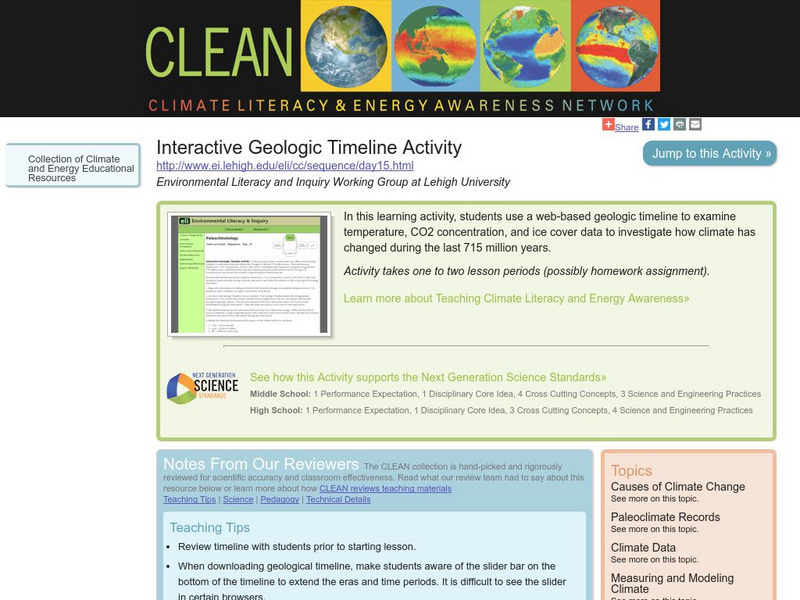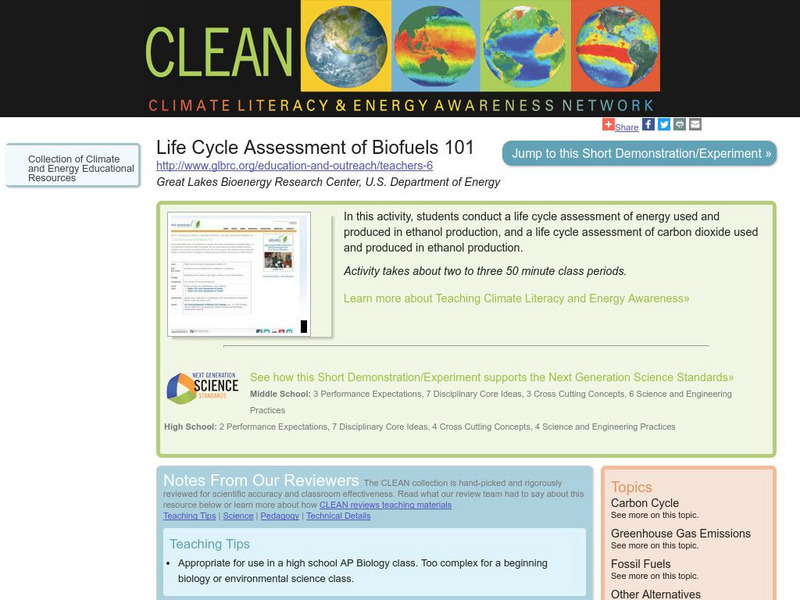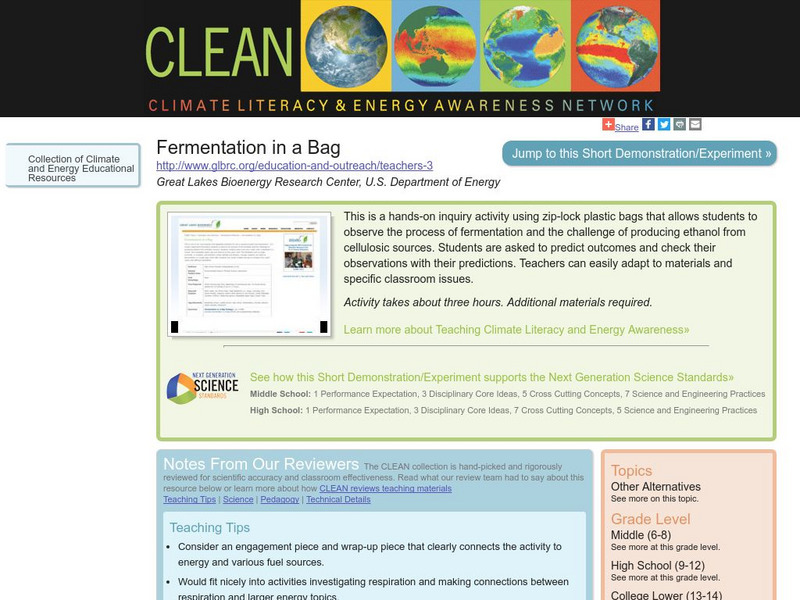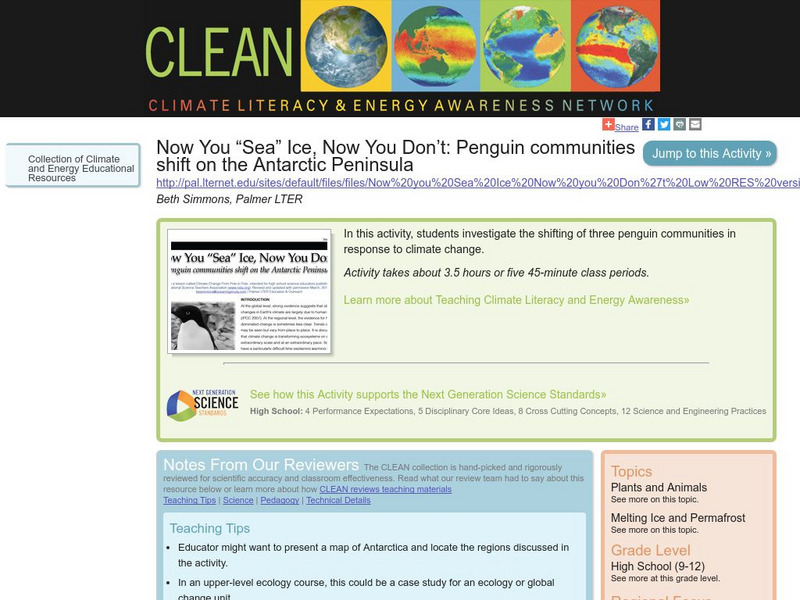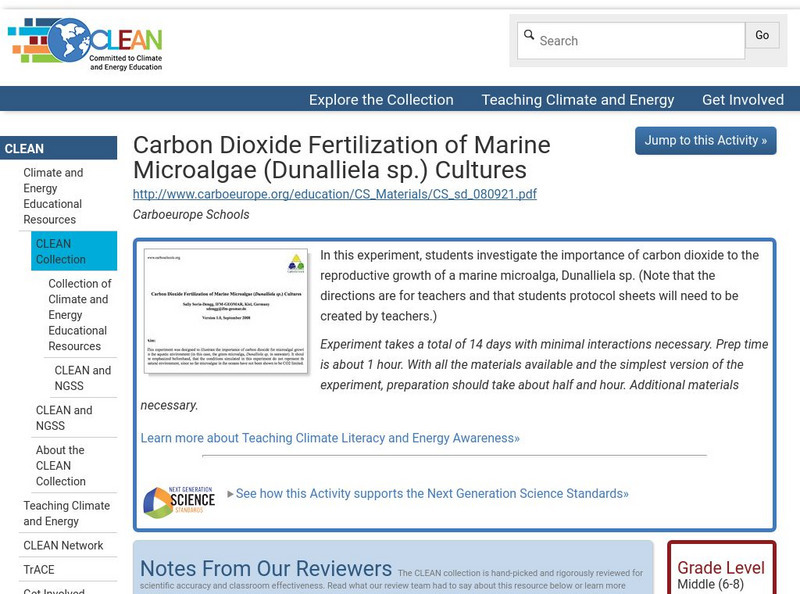Climate Literacy
Clean: Carbon Cycle
This activity from NOAA Earth System Research Laboratory introduces students to the current scientific understanding of the greenhouse effect and the carbon cycle. The activity leads them through several interactive tasks investigating...
Climate Literacy
Clean: Bering Sea Expedition
In this investigation learners research the effects of melting sea ice in the Bering Sea Ecosystem. They create research proposals to earn a place on the scientific research vessel Healy and present their findings and proposals to a...
Climate Literacy
Clean: Car Quest
In this activity, students will determine the environmental effects of existing cars and a fleet consisting of their dream cars. They compute how many tons of heat-trapping gases are produced each year, how much it costs to fuel the...
Climate Literacy
Clean: How Does Temperature Affect the Solubility of Co2 in Water?
This short investigation from Carbo Europe explores how temperature relates to the solubility of carbon dioxide in water.
Climate Literacy
Clean: Uptake of Carbon Dioxide From Water by Plants
Two simple experimental demonstrations show the role of plants in mitigating the acidification caused when carbon dioxide is dissolved in water.
Climate Literacy
Clean: Interactive Geologic Timeline Activity
In this learning activity, students use a web-based geologic timeline to examine temperature, CO2 concentration, and ice cover data to investigate how climate has changed during the last 715 million years. Students will gain an...
Climate Literacy
Clean: Carbon Calculator Activity
In this learning activity, students use a web-based carbon calculator to determine their carbon footprint on the basis of their personal and household habits and choices. Students identify which personal activities and household choices...
Climate Literacy
Clean: Understanding Ocean Acidification
The following is a series of 5 activities regarding ocean acidifcation Students will learn about rising Carbon Dioxide in the atmosphere, climate change, ocean reefs, marine calcifers and ocean pH.
Climate Literacy
Clean: Global Ocean Conveyor Belt
This hands-on activity explores the driving forces behind global thermohaline circulation.
Climate Literacy
Clean: How Much Energy Is on My Plate?
This activity leads students through a sequence of learning steps that highlight the embedded energy that is necessary to produce various types of food. Students start by thinking through the components of a basic meal and are later...
Climate Literacy
Clean: Life Cycle Assessment of Biofuels 101
Multi-instructional activity activity in which students conduct a life cycle assessment of energy and carbon dioxide used and produced in ethanol production.
Climate Literacy
Clean: Evaluating Woody Biomass Options for North Carolina's Electricity Future
In this activity, students learn about the pros and cons of co-firing woody biomass fuels with coal to produce electricity.
Climate Literacy
Clean: Fueling the Future: Evaluating the Sustainability of Biofuels
Students consider the impact and sustainability of use of different biofuels on the economy, the environment, and society. Students also learn about bioelectricity and how converting biomass to electricity may be the more efficient way...
Climate Literacy
Clean: Fermentation in a Bag
A hands-on inquiry activity using zip-lock plastic bags that allows students to observe the process of fermentation and the challenge of producing ethanol from cellulosic sources. Students are asked to predict outcomes and check their...
Climate Literacy
Clean: Time Series: Uncovering the Hidden Processes in Science
In the following exercise, students will review techniques useful to scientists asthey analyze series of data. Learn about scientific observation and try to recognize a pattern or trend within the data.
Climate Literacy
Clean: Penguin Communities Shift on the Antarctic Peninsula
This multi-lesson activity investigates the shifting of three penguin communities in Antarctica in response to climate change.
Climate Literacy
Clean: It's Time to Tell the Story About Buds, Leaves and Global Warming
In this activity, students explore how, in New England, the timing of color change and leaf drop of deciduous trees is changing.
Climate Literacy
Clean: Investigating Behavior of Krill
In this lab activity, learners use brine shrimp as a substitute for krill to investigate how changes in environmental factors affect behavioral responses of krill in the unique environment of Antarctica.
Climate Literacy
Clean: Introduction to Earth's Climate
This instructional activity is an introduction to Earth's climate and covers key principles regarding Earth's unique climate, atmosphere, and regional and temporal climate differences. Students will gain an understanding of how the...
Climate Literacy
Clean: A Global Issue: The Impacts of Climate Change
This is lesson five of a 9-lesson module. Activity explores the effects of climate change on different parts of the Earth system and on human well-being: polar regions, coral reefs, disease vectors, extreme weather, and biodiversity.
Climate Literacy
Clean: Hurricanes as Heat Engines
For this activity, students examine the effects of hurricanes on sea surface temperature using NASA data. They examine authentic sea surface temperature data to explore how hurricanes extract heat energy from the ocean surface.
Climate Literacy
Clean: Greenhouse Gases: A Closer Look
One activity in a larger module covering different aspects of the major greenhouse gases including some of the ways in which human activities are affecting the atmospheric concentrations of these key greenhouse gases.
Climate Literacy
Clean: Is Climate Change Happening?
A lesson studying climate change. Students will discuss how greenhouse gas concentrations relates to climate. This lesson is part of a series of nine-lesson module.
Climate Literacy
Clean: Carbon Dioxide Fertilization of Marine Microalgae Cultures
In this experiment, students investigate the importance of carbon dioxide to the reproductive growth of a marine microalga, Dunalliela sp.







